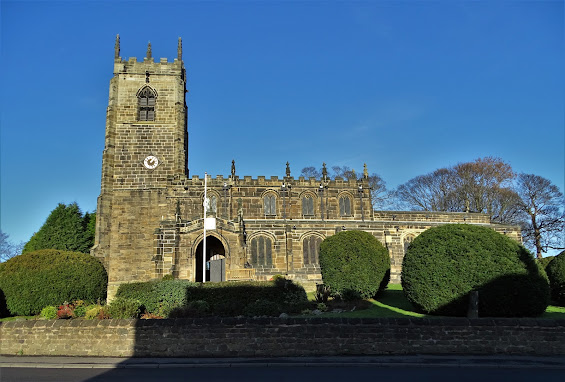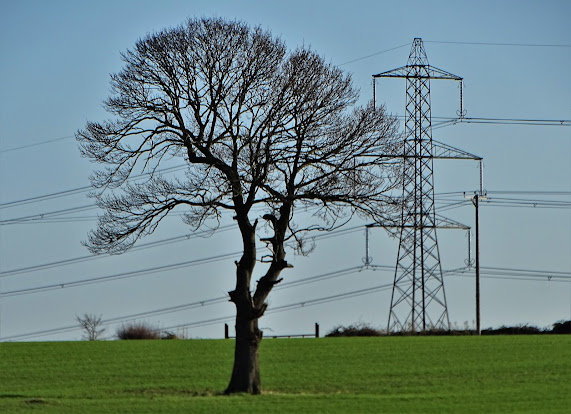Today I walked north of Barnsley in what was once coal mining territory. This area was known for its piles of coal waste or what were called slag heaps. Some of us knew the district as The Yorkshire Alps because of those man-made hills. A few of the slag heaps were levelled or taken away but most still remain and are now grassed over. Not much remains of a once proud heritage that fuelled Britain's industrial revolution, its trains and its shipping. Some say that without coal The British Empire could never have been established.
At the top there's a picture of two Victorian cottages on Chapel Lane in Carlton. Below is the village's Anglican church - dedicated to St John the Evangelist. It was constructed in 1878/79 under the instructions of The Earl Wharncliffe who owned some of the local collieries and was fabulously rich.
And so was the Alexandra working men's club in nearby Royston. A working men's club was a place where both working men and their wives could socialise, enjoying reasonably priced alcoholic beverages. There would be weekend entertainment and attached sports clubs too. Most working men's clubs had their own football and cricket teams. There would also be outings to the coast for families and Christmas lunches for the elderly etcetera.
St John the Baptist Church in Royston was built in the 12th century and is Grade I listed. A beautiful building, it predates the age of industrialised coal mining by several centuries.
Finally, here's a photo I took of a lonesome tree and a pylon standing in the open land between Royston, Carlton and Athersley...









Isn't there a meal that can be ordered in pubs called a "working man's" lunch? And if so, was it named after something they would have sold in the WM Clubs?
ReplyDeleteThis does not ring a bell for me Jennifer.
DeleteIt is interesting to compare the different doors and windows on the pair of houses. I doubt either are the original shapes. The house on the right might have door closer to the original shape but I really doubt its windows are even close.
ReplyDeleteNot much of a prevailing wind to shape the lone tree.
I am certain that the house on the left has its original apertures.
DeleteThere are a lot of Carltons, even in Yorkshire.
ReplyDeleteBobby Carlton, Jackie Carlton and don't forget Eddie Carlton...
DeleteFine photos! I do not believe I had heard of the Working Man's Clubs but that makes a lot of sense. People tend to socialize with the people they work with anyway and I'm sure that these clubs helped to make people feel even more a part of the company. Or were they not companies but government owned?
ReplyDeleteThey were owned by the members and any profits were recycled. This remains the case today. In the late fifties/early sixties Britain's top pop groups and singers played the working men's club circuit - at least here in the north. They didn't have many WMC's in the south of England.
Delete"profits were recycled"
Deleteas they should be. That wouldn't happen in a government owned pub/club.
I have several ancestors who presumably came from coal mining in England to America for a better life. Most ended up mining coal or lead once they got here but I think eventually their families were able to achieve that better life.
ReplyDeleteThey couldn't achieve a better life if they weren't in England.
DeleteWhere I grew up (Northumberland) there were as many working men's clubs as pubs in some towns and nearby in Ashington there were, at one time, no pubs at all - just clubs! Carlton club looks good - just needs a H in it - ha ha - not that I'd be much use as I don't even drink!
ReplyDeleteI could teach you..."Now hold the glass steady Mark and guzzle like a goldfish. Soon you'll be tipsy and you'll have some great ideas for writing too."
DeleteMy wife was born in Barnsley and raised in Royston. Her claim to fame is when the kids would light a paper and put it up the down spout and it would make a loud noise.
ReplyDeleteI thought she was from Cudworth. If I had known she lived in Royston I could have taken a photo of her old house - if it is still standing.
DeleteI think her house/farm has ben redeveloped. The family has looked for it but can't find it.
DeleteCan Jean remember the address or what the farm/house was called?
DeleteWorking Men's Clubs seem to have served a useful purpose, then and now. Reasonably priced alcoholic beverages, indeed! That reminds me of some of the pubs of my youth in North Dakota. Not fancy but serviceable.
ReplyDeleteTake me back to the Black Hills
DeleteThe Black Hills of Dakota
To the beautiful Indian country
That I love
Great photos of your walk. Love the contrast of tree and pylon. My ancestors were coal miners in Lancashire and Yorkshire.I'm glad the slag heaps are gone or covered with vegetation.
ReplyDeleteIf a visitor didn't know beforehand, he or she would probably never guess that coal mining had ever taken place in this area Diane.
DeleteCarlton reminds me of Thurnscoe, Wath upon Dearne and other such places, surrounded by former slack heaps. The W.M. clubs are still active in some of them, but I guess many have shut down with today‘s working population not really interested in the kind of entertainment and social networking they provided. There is one in Ripon I have walked past countless times, on Kirkgate.
ReplyDeleteYou had very good weather! Here, it rained only once yesterday… from morning to night.
It was a lovely, bright day - so much colour after recent overcast days. By the way, the piles were slag heaps not slack heaps.
DeleteJennifer may be referring to the traditional Ploughman's Lunch? Though it depends upon where you lived - Faggots and peas was (is?) another popular pub lunch.
ReplyDeleteAndrew is correct about the houses in the first photo. The windows would have originally been sash style and the front doors solid, panelled wood. Thousands (if not millions) of that style of cottage must have been built in Victorian times, and are still standing today.
Good to see that you've been out and about with your trusty camera in such sunny weather, YP. The upper storey on the Carlton church seems rather strange - not the graceful spire or tower we're used to seeing.
I agree with you about that tower. Maybe The Earl of Wharncliffe had seen a similar tower on his travels elsewhere.
DeleteThose Victorian cottage so dissimilar to each other, individual taste. Did you make a note of what the green plaque said? Can there be a time when working man's club and cheap pubs existed? Aspiration to do better has not led us down a very good path;)
ReplyDeleteI am afraid I do not see a green plaque Thelma.
DeleteOh. I see that plaque now. It reads "GORDON VILLAS 1898".
DeleteWasn't Kes set in Barnsley? I use to watch the television series Sam starring a future Taggart star. Carlton Palmer played for Sheffield Wednesday if I recall.
ReplyDeleteI don't think Carlton Palmer was named after the village of Carlton. He also played for England and I saw him in a small bistro restaurant once. He knew how to hold his knife and fork properly.
Delete"Kes" was indeed set in the Barnsley region. When I think of Barnsley I think of honesty, good humour, hard work, straightforwardness and The Barnsley Chop which is not a move in karate.
I can see a green plaque upstairs in the houses in the top photograph. Saxon the Heavy Rock band are from Barnsley. I've seem them play and Biff always says some witty remarks.
ReplyDeleteAh- yes! You are right Big Chief Eagle Eye! It says "Gordon Villas 1898".
DeleteThe St. John the Baptist church is especially nice. It's hard to imagine northern and middle England before coal and industry transformed the landscape. Think what it must have been like in the 12th century when that church was built, all that coal still waiting underground.
ReplyDeleteThe population of England at that time would have been around four million compared with 56 million today. I find that fact mindblowing.
DeleteYou won't see many of today's modern buildings lasting that long.
ReplyDelete